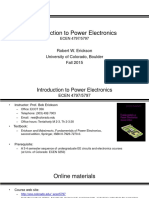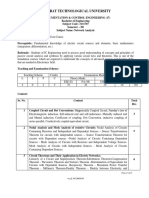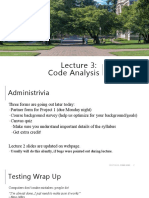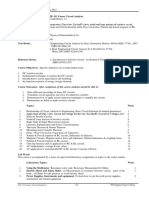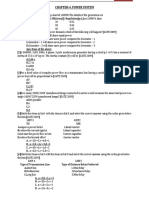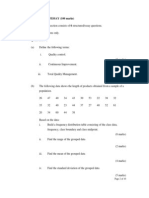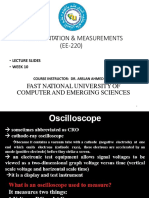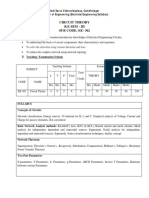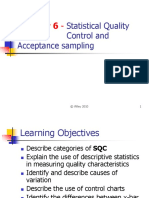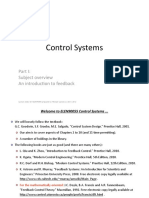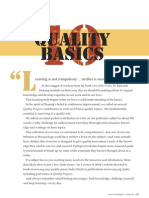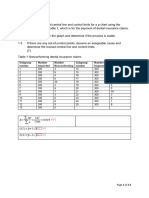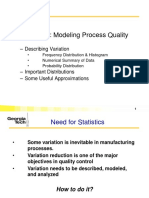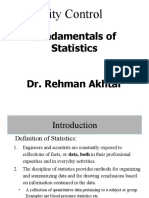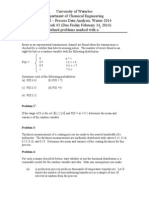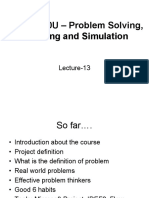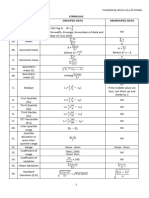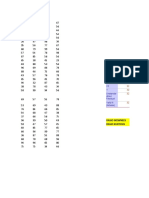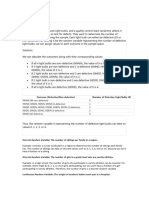Quality Control
(MANE 4045)
Instructor: Dr. Sayyed Ali Hosseini
Winter 2015
Lecture #3
With many figures and definitions from Introduction To Statistical Quality Control ,7th Edition by Douglas C. Montgomery
Copyright (c) 2012 John Wiley & Sons, Inc.
�In the last lecture, we covered Part 1 Introduction:
The DMAIC Process
Lecture #3
Today, we will cover Part 2 Statistical Methods Useful In Quality Control
And Improvement:
Modeling Process Quality
�Learning Objectives
Simple tools of descriptive statistics to express variation
quantitatively in a quality characteristic when a sample of
data on this characteristic is available.
Introduce probability distributions and show how they
provide a tool for modeling or describing the quality
characteristics of a process.
MANE4045 Quality Control
Lecture #3
�Statistics
Statistics help us understand everything by collecting,
tabulating, analysis, interpretation, and presentation of
numerical data, provide a viable method of supporting or
clarifying a topic under discussion.
MANE4045 Quality Control
Lecture #3
�Describing Variation (The Histogram)
A histogram is a more compact summary of data.
Group values of the variable into bins, then count the number of
observations that fall into each bin.
Plot frequency (or relative frequency) versus the values of the variable.
In order to construct a histogram,
Histograms can be relatively sensitive to the choice of the number and
width of the bins.
For small data sets, histograms may change dramatically in appearance
if the number and/or width of the bins changes.
Histogram can be considered as a technique best suited for larger data
sets containing, say, 75 to 100 or more observations.
MANE4045 Quality Control
Lecture #3
�An Example of Histogram for a Continuous Variable
MANE4045 Quality Control
Lecture #3
�An Example of Histogram for a Discrete Variable
MANE4045 Quality Control
Lecture #3
�Describing Variation (Numerical Summary of Data)
Suppose that , , . . . , are the observations in a sample.
The most important measure of central tendency in the sample
is the sample average.
=
+ +
The sample average is simply the arithmetic mean of the observations.
The sample average is the point at which the histogram exactly balances.
Thus, the sample average represents the center of mass of the sample data.
MANE4045 Quality Control
Lecture #3
�Describing Variation (Numerical Summary of Data)
The variability in the sample data is measured by the sample
variance.
=
1
The units of the sample variance is the square of the original units of the
data which is often inconvenient and awkward to interpret.
Hence, normally the square root of
which is called the sample standard
deviation s is being used as a measure of variability..
=
MANE4045 Quality Control
1
Lecture #3
�Describing Variation (Probability Distributions)
By using statistical methods, we may be able to analyze the
data (e.g. sample layer thickness of the wafers) and draw
certain conclusions about the process that generates that data
(e.g. process to manufacture the wafers).
A probability distribution is a mathematical model that relates
the value of the variable with the probability of occurrence of
that value in the population.
There are two types of probability distributions:
Continuous distributions
Discrete distributions
MANE4045 Quality Control
Lecture #3
10
�Describing Variation (Probability Distributions)
Continuous distributions
When the variable being measured is expressed on a
continuous scale, its probability distribution is called a
continuous distribution.
Discrete distributions
When the parameter being measured can only take on certain
values, such as the integers 0, 1, 2, ..., the probability
distribution is called a discrete distribution.
=
MANE4045 Quality Control
= ( )
Lecture #3
11
�Describing Variation (Probability Distributions)
Sometimes called a
probability mass function
MANE4045 Quality Control
Sometimes called a
probability density function
Lecture #3
12
�Some Important Discrete Distributions
The Binomial Distribution
Reminder:
!
"
(Basis is in Bernoulli trials)
where the random variable
is the
number of successes out of
Bernoulli trials with constant
probability of success on each trial.
MANE4045 Quality Control
Lecture #3
13
�Example #1
A manufacturing process produces thousands of semiconductor
chips per day. On the average, 1% of these chips do not conform
to specifications. Every hour, an inspector selects a random
sample of 25 chips and classifies each chip in the sample as
conforming or nonconforming. calculate the probability of finding
one or fewer nonconforming parts in the sample.
MANE4045 Quality Control
Lecture #3
14
�Example #1 Solution
If we let be the random variable representing the number of nonconforming
chips in the sample, then the probability distribution of is
=
25
1 =
0.01
0.99
'"
=0 +
25!
0.01
0! 25 0 !
0.99
=1 =
'")
MANE4045 Quality Control
0 +
1 =(
25!
0.01
1! 25 1 !
25
0.99
Lecture #3
0.01
'"
0.99
'"
= 0.7778 + 0.1964 = 0.9742
15
�Some Important Discrete Distributions
The Poisson Distribution
A typical application of the Poisson distribution in quality control
is as a model of the number of defects or nonconformities that
occur in a unit of product.
MANE4045 Quality Control
Lecture #3
16
�Example #2
Assume that the number of wire-bonding defects per unit that
occur in a semiconductor device is Poisson distributed with
parameter . = 4. Calculate the probability that a randomly
selected semiconductor device will contain two or fewer wirebonding defects.
MANE4045 Quality Control
Lecture #3
17
�Example #2 Solution
2 =
=0 +
=1 +
=2 =
/ "0 4
= 0.018316 + 0.073263 + 0.146525 = 0.238104
(
!
)
MANE4045 Quality Control
Lecture #3
18
�Some Important Continuous Distributions
The Normal Distribution
The normal distribution is used so much that we frequently
employ a special notation, 2(3, 4 ), to imply that
is
normally distributed with mean 3 and variance 4 . The visual
appearance of the normal distribution is a symmetric, unimodal
or bell-shaped curve.
MANE4045 Quality Control
Lecture #3
19
�Some Important Continuous Distributions
The Normal Distribution
MANE4045 Quality Control
Lecture #3
20
�Some Important Continuous Distributions
The Normal Distribution (An Important Reminder from Statistics)
The cumulative normal distribution is defined as the probability that
the normal random variable is less than or equal to some value , or
=5
": 4
26
"
"7 9
8
This integral cannot be evaluated in closed form. However, by using the
change of variable (which is called standardization):
;=
3
4
The evaluation can be made independent of 3 and 4 as follows:
3
=
4
3
4
Where is the cumulative distribution function of the standard normal
distribution (mean = 0, standard deviation = 1). (See table II in text book Appendix)
MANE4045 Quality Control
Lecture #3
21
�Example #3
The tensile strength of paper used to make grocery bags is an
important quality characteristic. It is known that the strength ( )
is normally distributed with mean 3 = 40 = /? and standard
deviation 4 = 2 = /? , which denoted 2(3, 4 ) or
2(40, 2 ). The purchaser of the bags requires them to have a
strength of at least 35 lb/in2. Calculate the probability that bags
produced from this paper will meet or exceed the specification.
MANE4045 Quality Control
Lecture #3
22
�Example #3 Solution
The probability that a bag produced from this paper will meet or exceed the
specification is:
35 = 1 { 35}
we need to standardize this distribution to be able to use the table in
appendix because that table is prepared for a normal distribution with
mean 3 = 0 and standard deviation 4 = 1.
3
=
4
35 40
=
2
; 2.5 = 2.5
If we refer to the table, it can be seen that the
data is available only for positive magnitudes; so,
2.5 = 1 +2.5 = 1 0.99379 = 0.00621
And finally, the desired probability is:
35 = 1 0.0062 = 0.9938
MANE4045 Quality Control
Lecture #3
23
�Some Important Continuous Distributions
The Exponential Distribution
The exponential distribution is widely used in the field of reliability
engineering as a model of the time to failure of a component or
system. In these applications, the parameter . is called the failure rate
of the system, and the mean of the distribution 3 = is called the
C
mean time to failure.
MANE4045 Quality Control
Lecture #3
24
�Example #4
An electronic component in an airborne radar system has a useful
life described by an exponential distribution with failure rate of
10"0 /. What is the mean time to failure for this components?
Determine the probability that this component would fail before
its expected life.
MANE4045 Quality Control
Lecture #3
25
�Example #4 Solution
10"0
?EFG/ G H/ ?
. = 10"0 J/
1
=
.
C
)
H?J/ HK
?EFG/ 3 =
1
1
= "0 = 100 = 10000 G .
. 10
./ "CL H = 1 / " = 0.63212
MANE4045 Quality Control
Lecture #3
26



